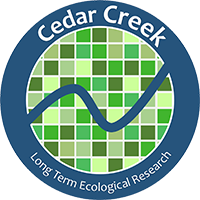In 1996 E142 was established in field D on top of the E004 macroplots. E004 was conducted in fields A, B, C and D by Dave Tilman. The purpose of E004 was to see what effect NH4NO3 addition has on large areas over a longer period of time with exposure to naturally-occurring levels of herbivory. The nutrient addition treatments in E004, E142 plots have been applied annually since 1982. These experiments, along with others at Cedar Creek, examine the community and ecosystem consequences of chronic nutrient loading.
Plots are sampled under, and outside of, the tree canopy in Cedar Creek's oak savanna.
Experiment Design
from: Avis, P. G., D. J. McLaughlin, B. C. Dentinger, and P. B. Reich. 2003. Long-term increase in nitrogen supply alters above- and below-ground ectomycorrhizal communities and increases the dominance of Russula spp. in a temperate oak savanna. New Phytologist 160:239-253. doi:10.1046/j.1469-8137.2003.00865.x
Plot Layout and Point Selection
Plots for this experiment are 20 x 50 meters. In 1996, within each of the 9 D004 macroplots, 8 sampling points were randomly placed in areas with oak overstory canopy present and 8 were placed in areas with no overstory canopy cover. Random coordinates were drawn until the 16 points had been located within the proper category of canopy condition. 'IN' plots were underneath the tree canopy cover when selected in 1996, 'OUT' plots were outside the tree canopy cover.
Fertilization
Plots were randomly assigned to one of two fertilizer treatments or unfertilized control. Unfertilized 1 m boundary areas separated adjacent plots. The fertilizer treatments include two levels of nitrogen:
High: 50 g N m − 2 yr-1
Low: 16 g N m − 2 yr-1
added as NH 4 NO 3 (commercial 34-0-0) ‘slow release’ pellets.
To offset indirect effects of N addition, each fertilization treatment also received equal background levels of P, K, Ca, Mg, S and citrate-chelated trace metals applied in the following forms and rates:
P 2 O 5 , 20.0 g m − 2 yr − 1 (as commercial 0-46-0 fertilizer)
K 2 O, 20.0 g m − 2 yr − 1 (commercial 0-0-61)
CaCO 3 , 40.0 g m − 2 yr − 1 (as fine-ground commercial lime)
MgSO 4 , 30.0 g m − 2 yr − 1 (US Pure Epsom salts)
CuSO 4 , 18.0 µg m − 2 yr − 1
ZnSO 4 , 37.7 µg m − 2 yr − 1
CoCO 2 , 15.3 µg m − 2 yr − 1
MnCl 2 , 322.0 µg m − 2 yr − 1
NaMoO 4 , 15.1 µg m − 2 yr − 1
H 3 BO 3 , 12.0 µg m − 2 yr − 1 .
Control plots remained unfertilized. Fertilization occurs twice annually in mid-May and in mid-June.
Treatment Tables
Download treatment tables (zip file)
Data
Select Publications
Long‐term increase in nitrogen supply alters above‐ and below‐ground ectomycorrhizal communities and increases the dominance of Russula spp. in a temperate oak savanna
PG Avis, DJ McLaughlin, BC Dentinger, PB Reich
2003 New Phytologist 160 (1), 239-253
Positive feedbacks between decomposition and soil nitrogen availability along fertility gradients
MD Norris, PG Avis, PB Reich, SE Hobbie
2013 Plant and soil 367, 347-361
Modest enhancement of nitrogen conservation via retranslocation in response to gradients in N supply and leaf N status
MD Norris, PB Reich
2009 Plant and Soil 316, 193-204
